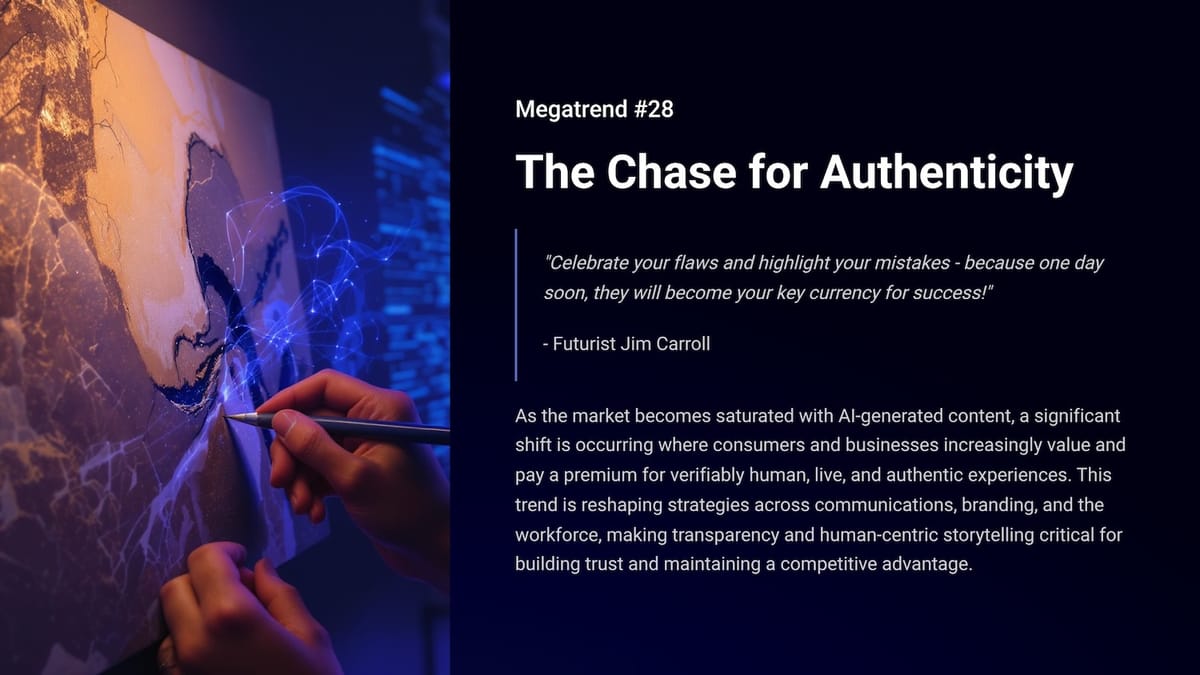"Celebrate your flaws and highlight your mistakes - because one day soon, they will become your key currency for success!" - Futurist Jim Carroll
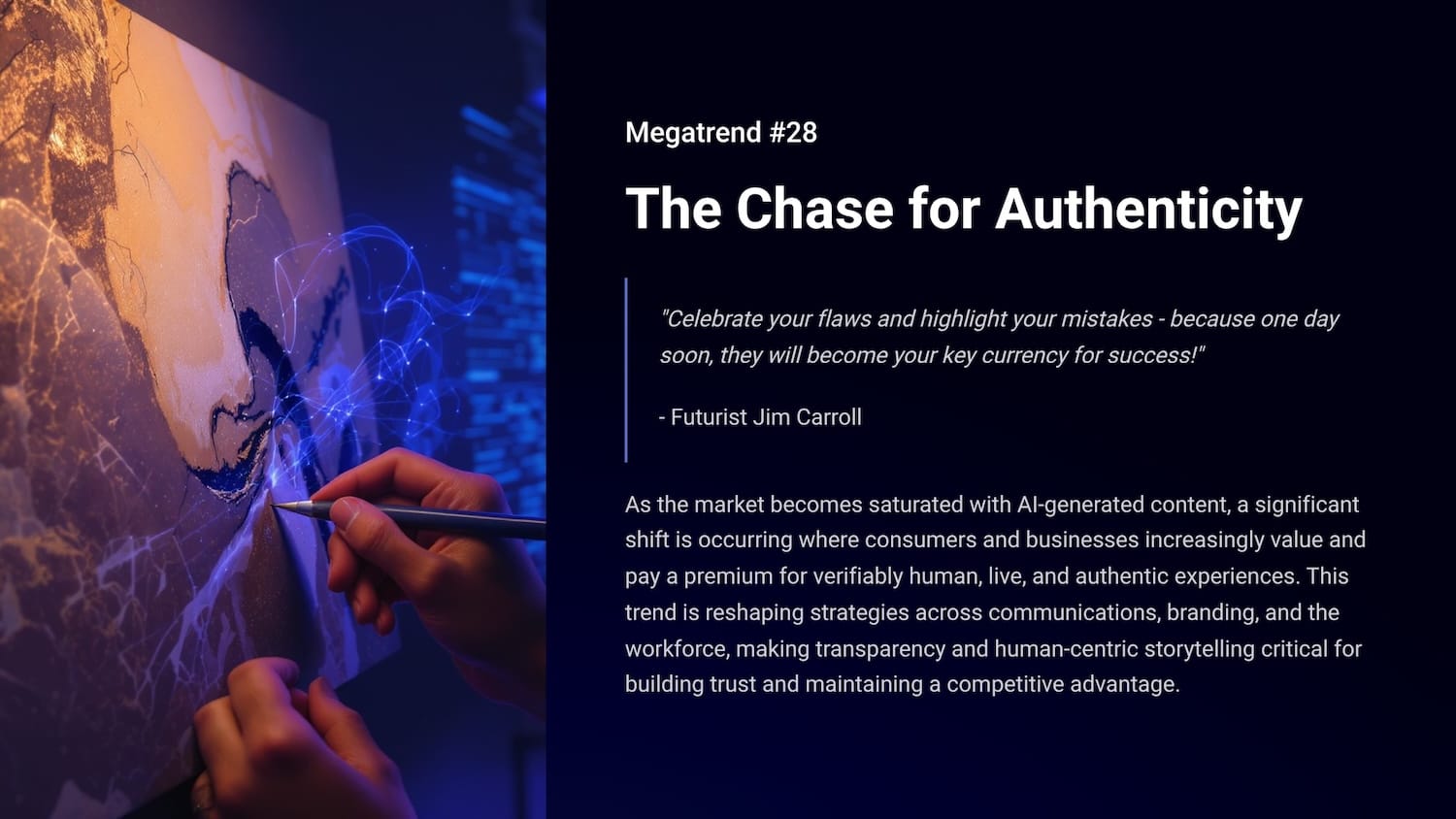
(Futurist Jim Carroll is writing a series on 30 Megatrends, which he first outlined in his book Dancing in the Rain: How Bold Leaders Grow Stronger in Stormy Times. The trends were shared in the book as a way of demonstrating that, despite any period of economic volatility, there is always long-term opportunity to be found. The book is now in print - learn more at dancing.jimcarroll.com)
As the market becomes saturated with AI-generated content, a significant shift is occurring where consumers and businesses increasingly value and pay a premium for verifiably human, live, and authentic experiences. This trend is reshaping strategies across communications, branding, and the workforce, making transparency and human-centric storytelling critical for building trust and maintaining a competitive advantage.
In the era of AI, being real might become of a strategic advantage - meaning we're now in the weird situation in which it's certainly true that you have to master the skill of using AI, but not too much!
Overall, the trend involves what I call the Authenticity Premium. There's a full PDF here. which dives into it in a lot more depth.

The core shift? We're entering a market where synthetic content is cheap, constant, and often indistinguishable from the real thing.
The very ubiquity of AI-enhanced messaging, visuals, and personas is creating fatigue. People are already getting tired of "AI slop." In that fatigue, a counterforce is emerging: people will seek signals that what they're seeing, buying, or trusting is genuine. With that being the case, the "authenticity gap" is becoming a competitive battleground - organizations, professions, and industries are already finding value in "being real."
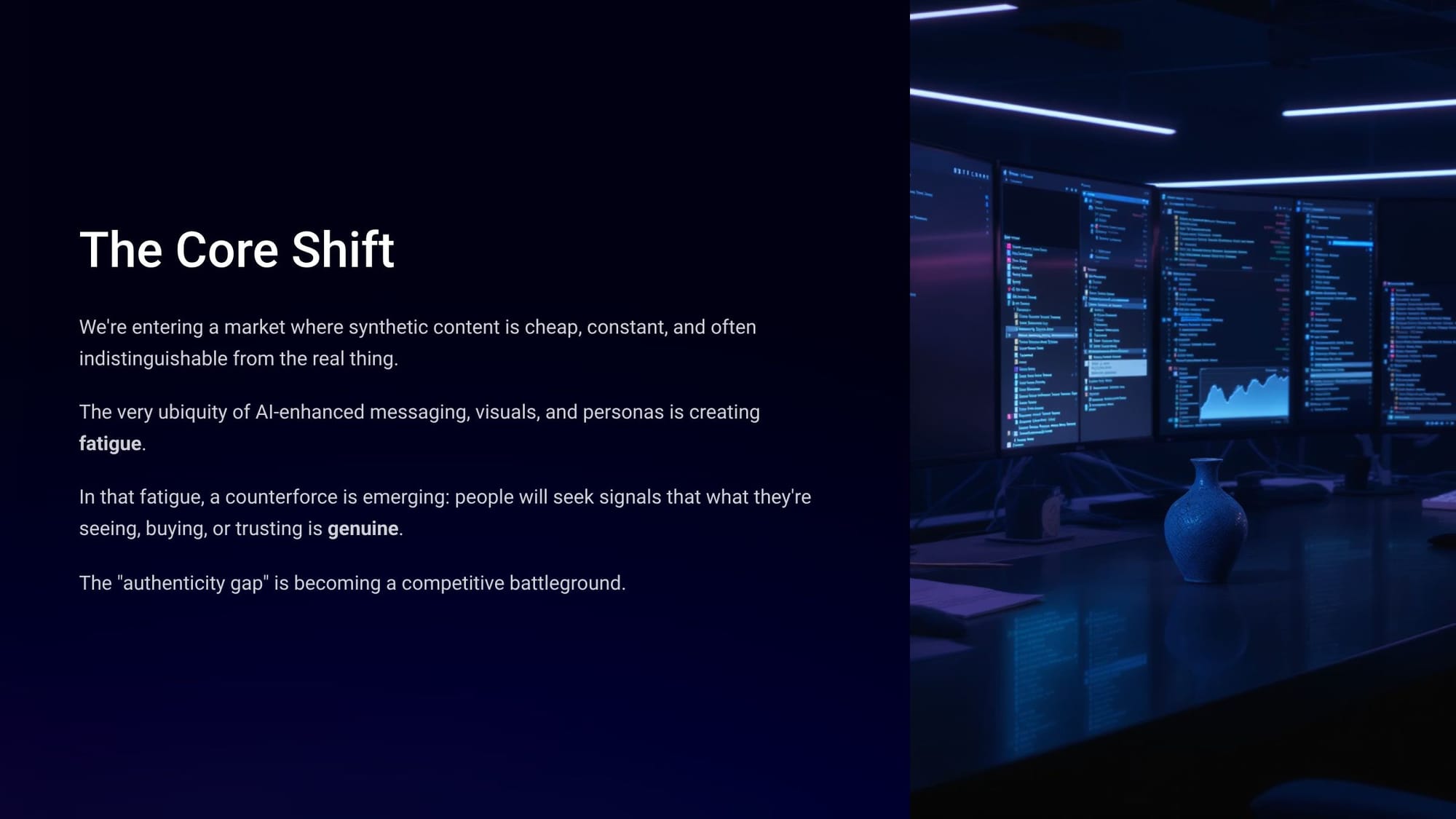
Why is this occurring? Simply put, the rapid integration of generative AI into every facet of content creation marks a fundamental inflection point in the digital economy. This technological shift is creating a new form of digital abundance, where synthetic, AI-generated content—text, images, music, and video—is not only ubiquitous but increasingly sophisticated. We can already barely tell the difference.
And it's happening quickly - as businesses adopt these tools, with 78% of organizations reporting AI use in 2024, up from 55% the prior year, the cost of producing seemingly perfect content is plummeting.
This abundance triggers a great inversion of value:
- When anything can be generated, polished, and replicated with near-zero cost, perfection ceases to be a marker of premium quality.
- Value migrates to the scarce, the unrepeatable, the tangible, and the verifiably human.
- The "Authenticity Premium" is not a rejection of technology, but a rational market rebalancing.
People will seek out and perhaps pay more, or pay more attention, to 'real stuff.'
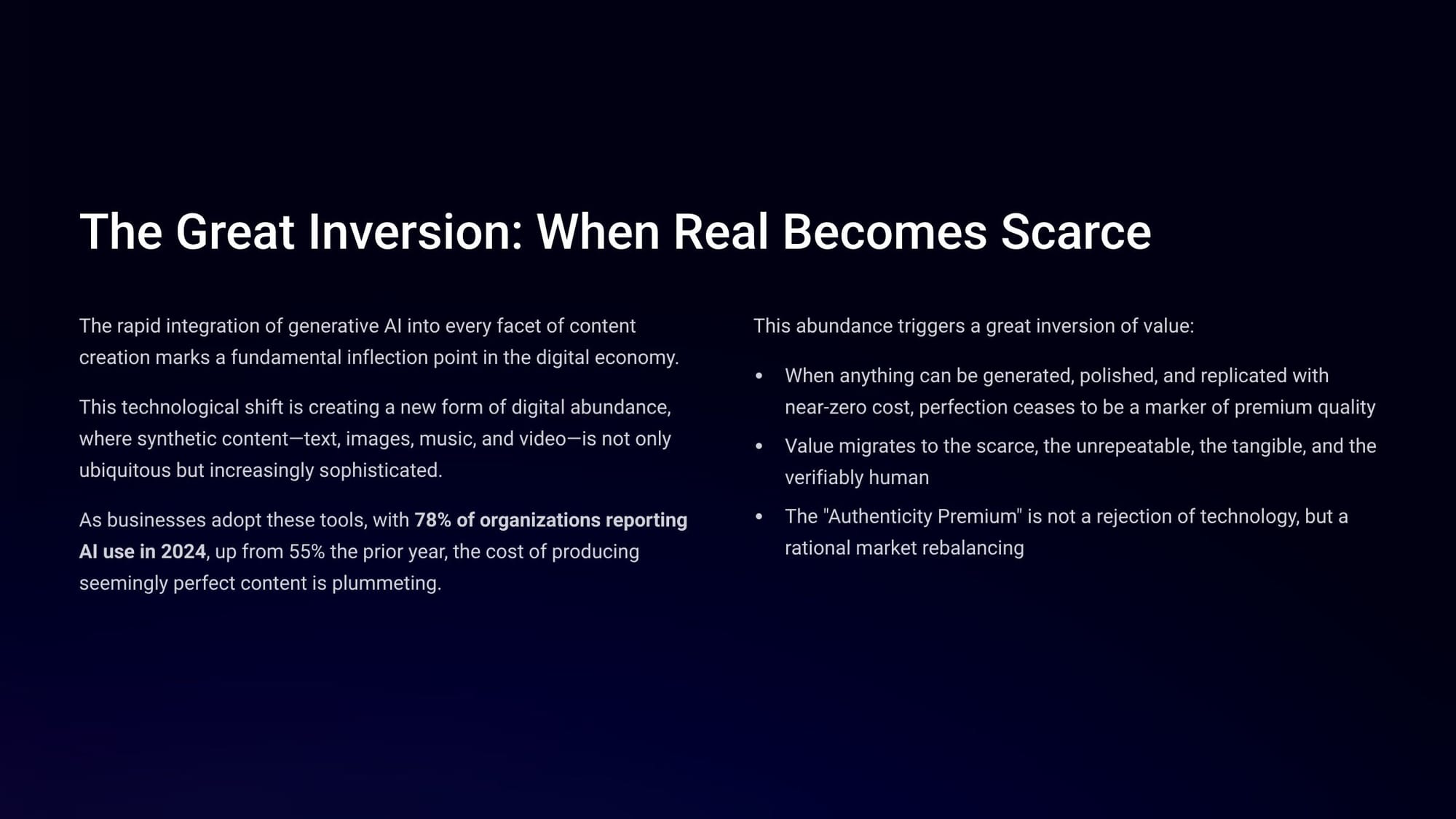
Why is that? It's the psychology of authenticity!
- Trust Deficit. Consumers are becoming more adept at identifying AI-generated content, with studies showing that half can now spot it. 52% of consumers report feeling less engaged with content they suspect is AI-written.
- Flight to Proof. As AI mimics authenticity signals, consumers seek out signals that are difficult or impossible to fake. The demand for "proofs of real" is a market-based defense mechanism against digital deception.
- Human Connection. Anxiety about the 'lack of a human being to connect with' has increased, a sentiment now shared by more than half of consumers. Behind-the-scenes content humanizes brands by revealing the unscripted, imperfect process of creation.
- Generational Shift. Gen Z has an innate expectation of authenticity, with 55% of consumers aged 16-24 favoring human-written content. 62% prefer brands that produce authentic and relatable content.
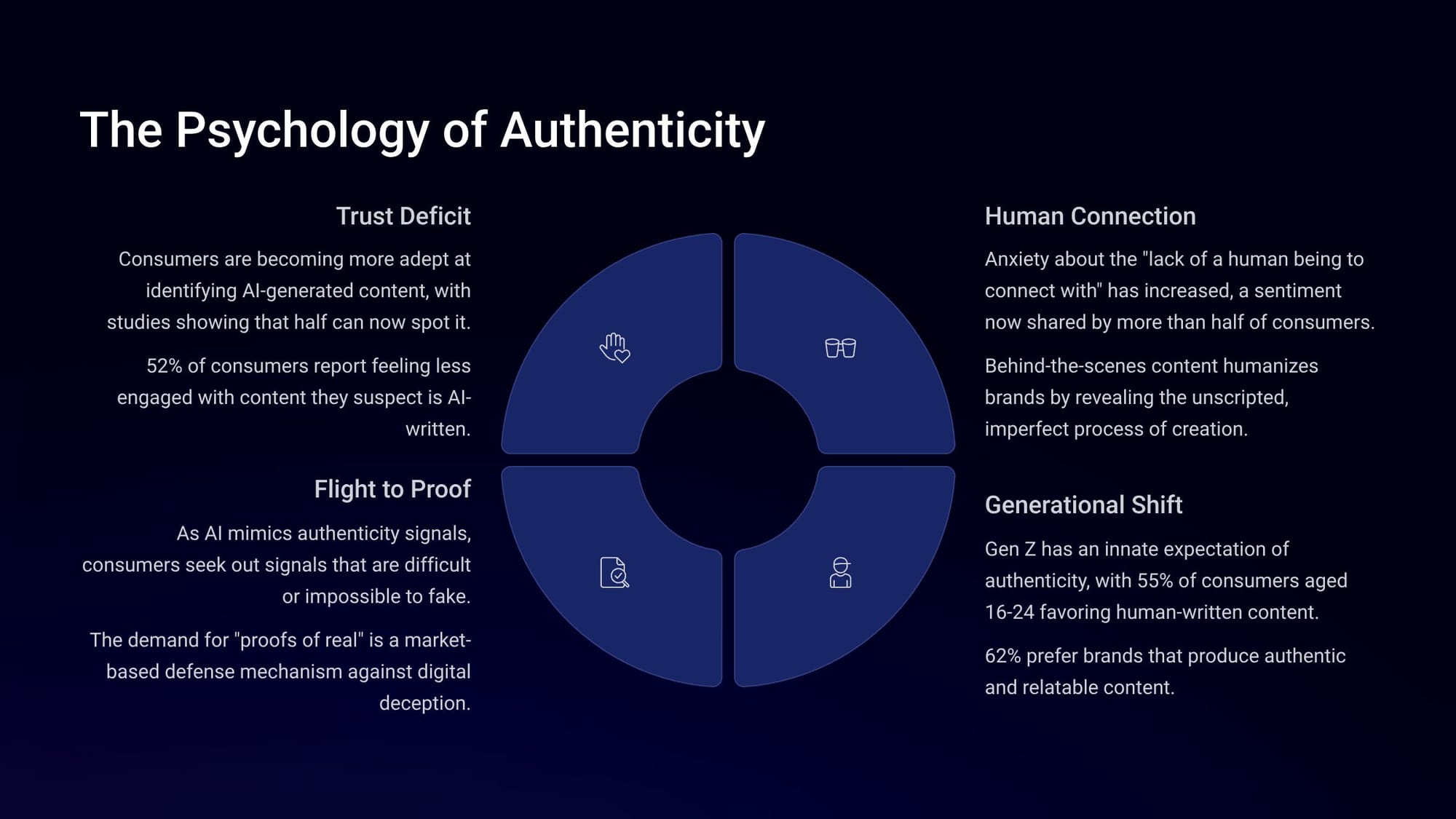
So, where does this lead? What should you do?
Consider how a few industries will need to adapt - and are already doing so. Consider communications & PR in the AI era:
- The Shift in Trust. When everyone can issue perfect, polished messaging at zero cost, trust will shift to voices that feel human, imperfect, and accountable.
- Leadership Visibility. CEOs will see more value in live, unedited formats — town halls, candid Q&A, unpolished LinkedIn videos — than in generic press releases.
- Crisis Response. Corporate crises will increasingly be judged on authentic human response times and tone, not just fact accuracy.
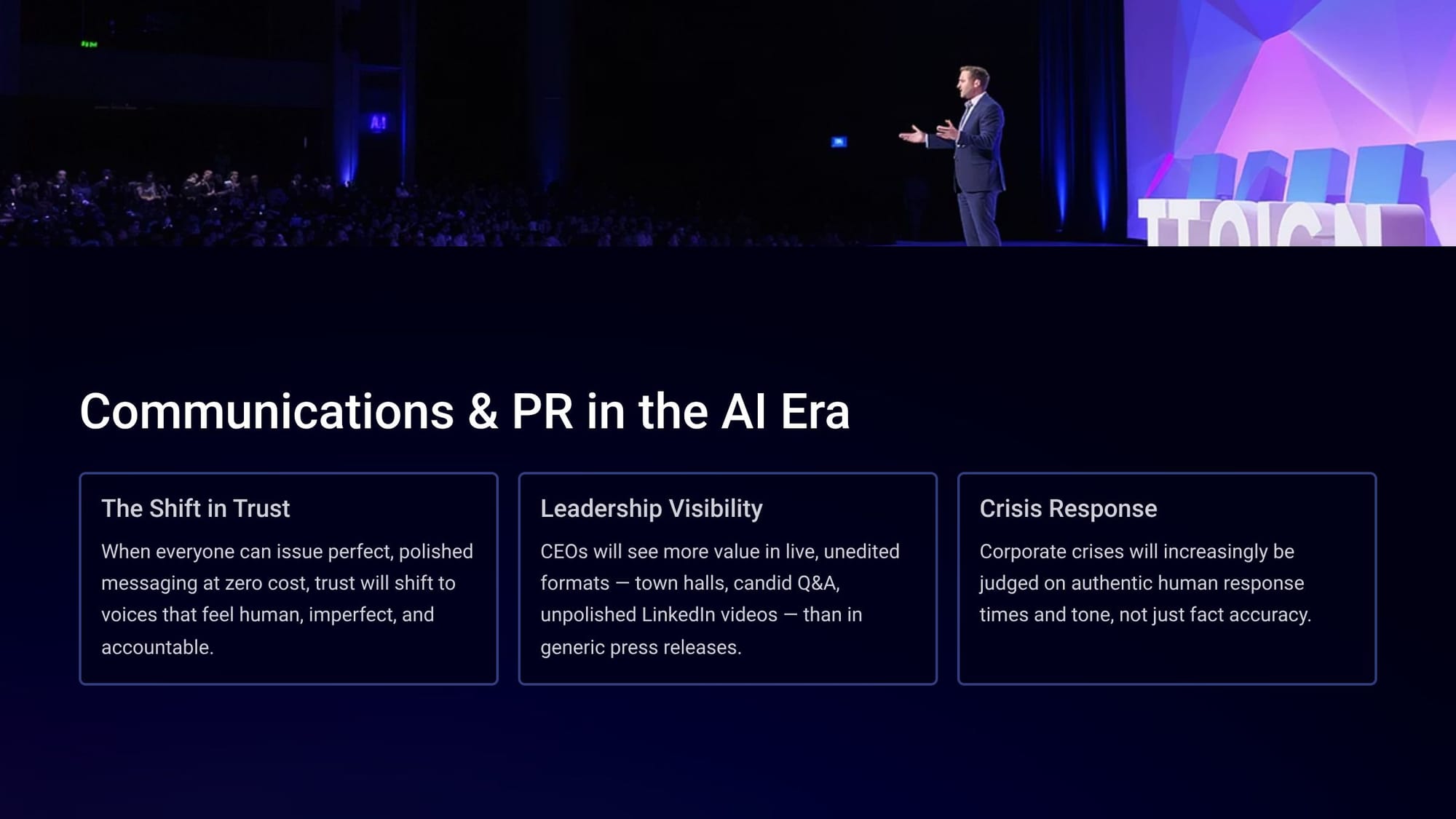
Ultimately, the world of branding & advertising, while currently working with AI-generated content, will see a transformation. Not only that, but the core message behind products will shift, focusing on 'real.'
- From Product to People. Brand stories will shift from "Here's our product" to "Here's who made it, why, and how."
- Unscripted Value. Unscripted customer stories and behind-the-scenes footage will carry more weight than stylized AI campaign imagery.
- Premium Proof. The next wave of 'premium' branding will include proof of origin and proof of process — not because the tech can't fake it, but because customers want reassurance that you didn't.

In particular, marketing will work hard to build customer trust:
- Content Authenticity Audits. Not just brand tone consistency, but verifying human authorship or decision-making in key campaigns.
- Human-Certified Branding. Consumers will start to notice (and pay more for) campaigns where the creative direction or execution came from humans with known track records.
- Human-in-the-Loop Value. Overuse of AI in customer engagement will drive people toward competitors who keep a live person in the loop.
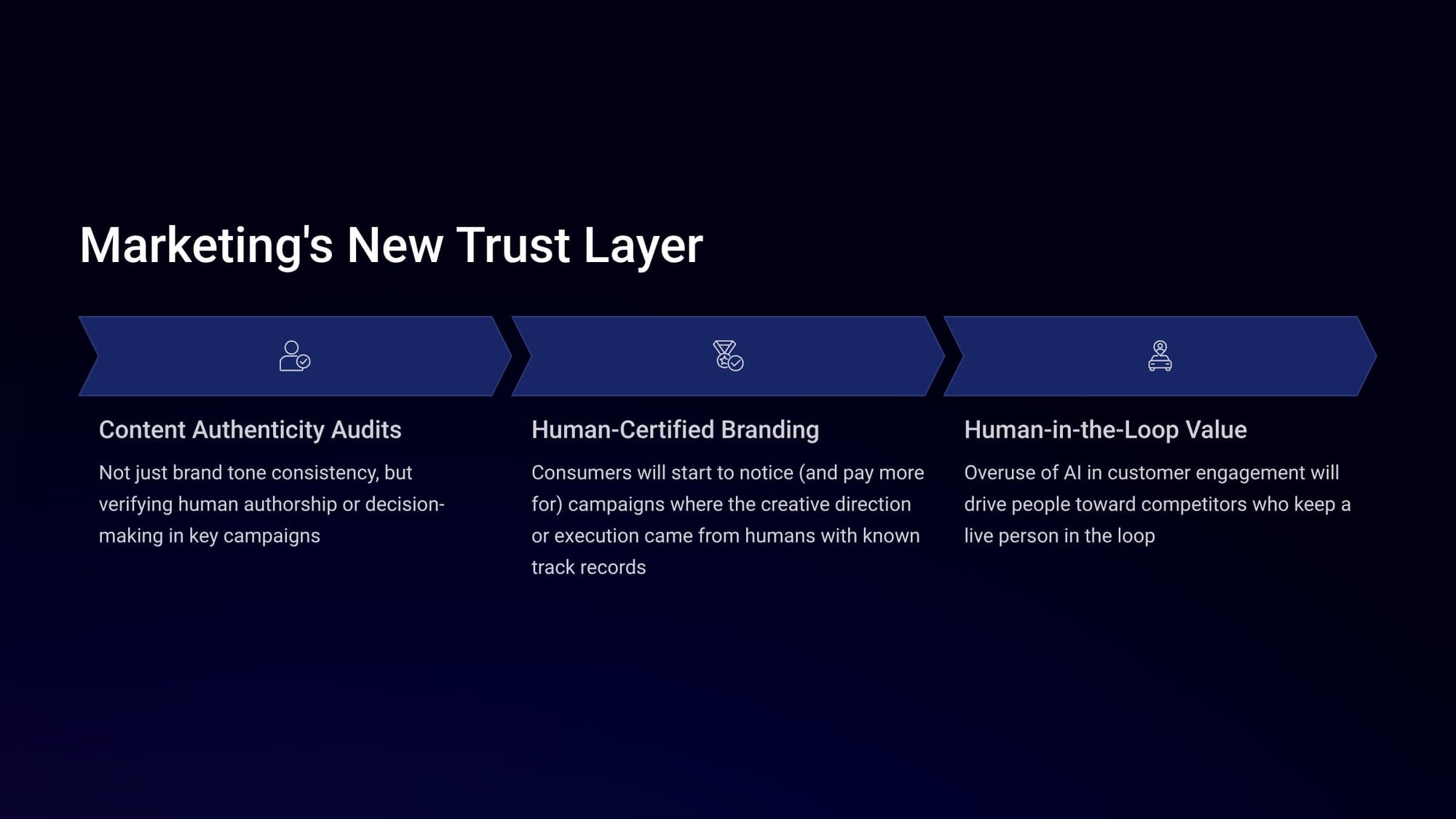
One of the areas being most impacted today by AI has to do with the workforce, particularly with recruiting, resumes, and hiring. AI can write flawless resumes, cover letters, and portfolios, which means flawless will soon mean generic. What will this lead to?
- Recruiters will value work samples that include context and decision-making stories, not just polished outputs.
- "Process narratives" will weigh more than AI-polished bullet points.
- LinkedIn profiles with visible proof of work will carry more influence than text-only profiles.
- The differentiator will be evidence of judgment — decisions you've made, trade-offs you've navigated, or values you've upheld under pressure.

This will lead to an overall change in how organizations deal with AI:
- Hiring and Talent. Companies will want proof that skills have been applied through job auditions, live problem-solving interviews, or simulation exercises. Hiring managers will become very skeptical of perfect submissions. Trust will go to those who can perform in the room.
- Leadership. Leaders will be evaluated not just on results but on perceived authenticity. Internal comms will move toward open forums, real conversations, and visible leadership presence, not just glossy CEO newsletters.
- Culture. AI will speed up processes but also create a "trust tax" — employees and customers will question whether what they see is "real." Recognition systems will increasingly favor relationship-building skills, ethical judgment, and collaboration — the things AI can't convincingly fake.
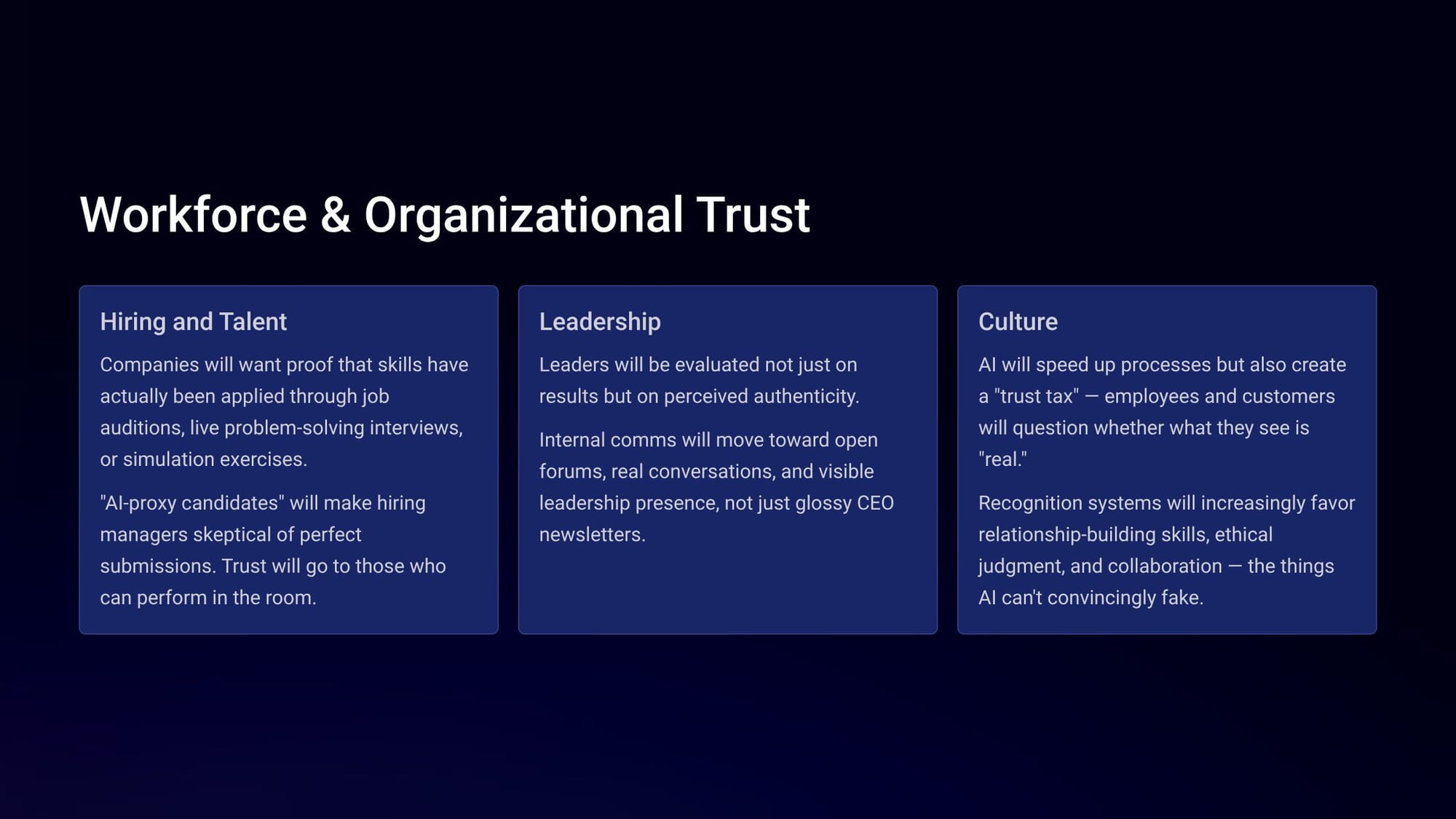
What all of this leads to is the ascendance of the human curator: people who sort through the massive amounts of material and use their humanness to guide others to what is real or helpful. As consumers become inundated with an infinite supply of algorithmically generated content, the true scarcity shifts from creation to selection.
The human curator solves the problem of "analysis paralysis" by offering:
- Trust and a distinct point of view
- Expert guidance through overwhelming choice
- A shared sense of taste and values
This creates a business model where profit is derived not from manufacturing goods, but from expertly guiding consumer choice.
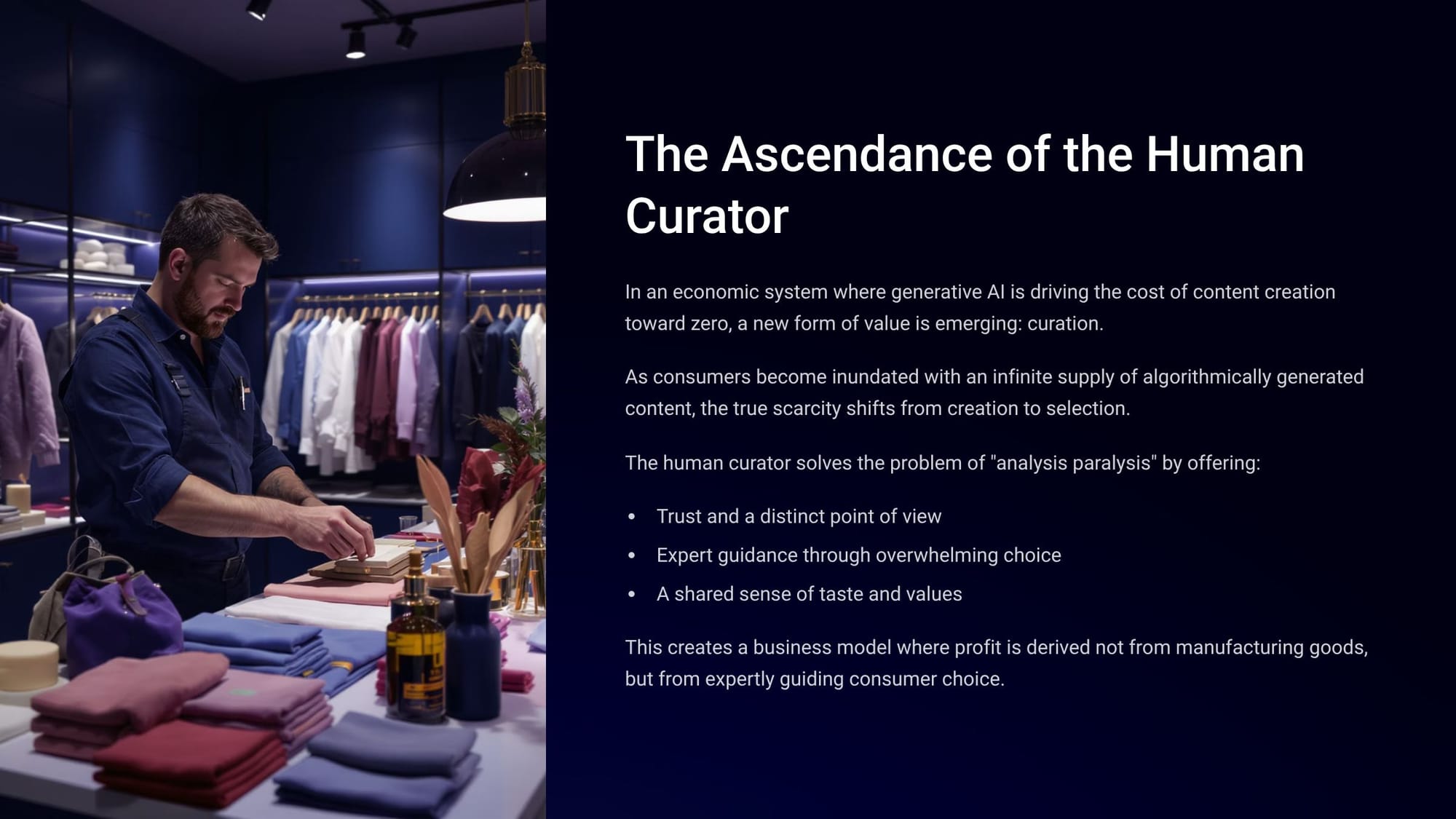
This is already happening in some industries:
- Independent Bookstores: Unable to compete with Amazon on price or logistics, their entire value proposition rests on curation. They build loyal communities through expert staff recommendations and a store atmosphere that reflects a specific, human-driven taste.
- Paid Newsletters: A dedicated audience will pay a premium for high-quality, curated information bundles that save them time and deliver targeted insights from trusted experts with a consistent point of view.
- Specialty Retail: Stores that focus on a specific niche and offer expert curation can thrive even in the age of e-commerce by providing a level of trust and expertise that algorithms cannot match.
The rise of the curator represents a fundamental value shift in the creative economy – a “service layer” of taste and trust built on top of an increasingly commoditized “content layer.”
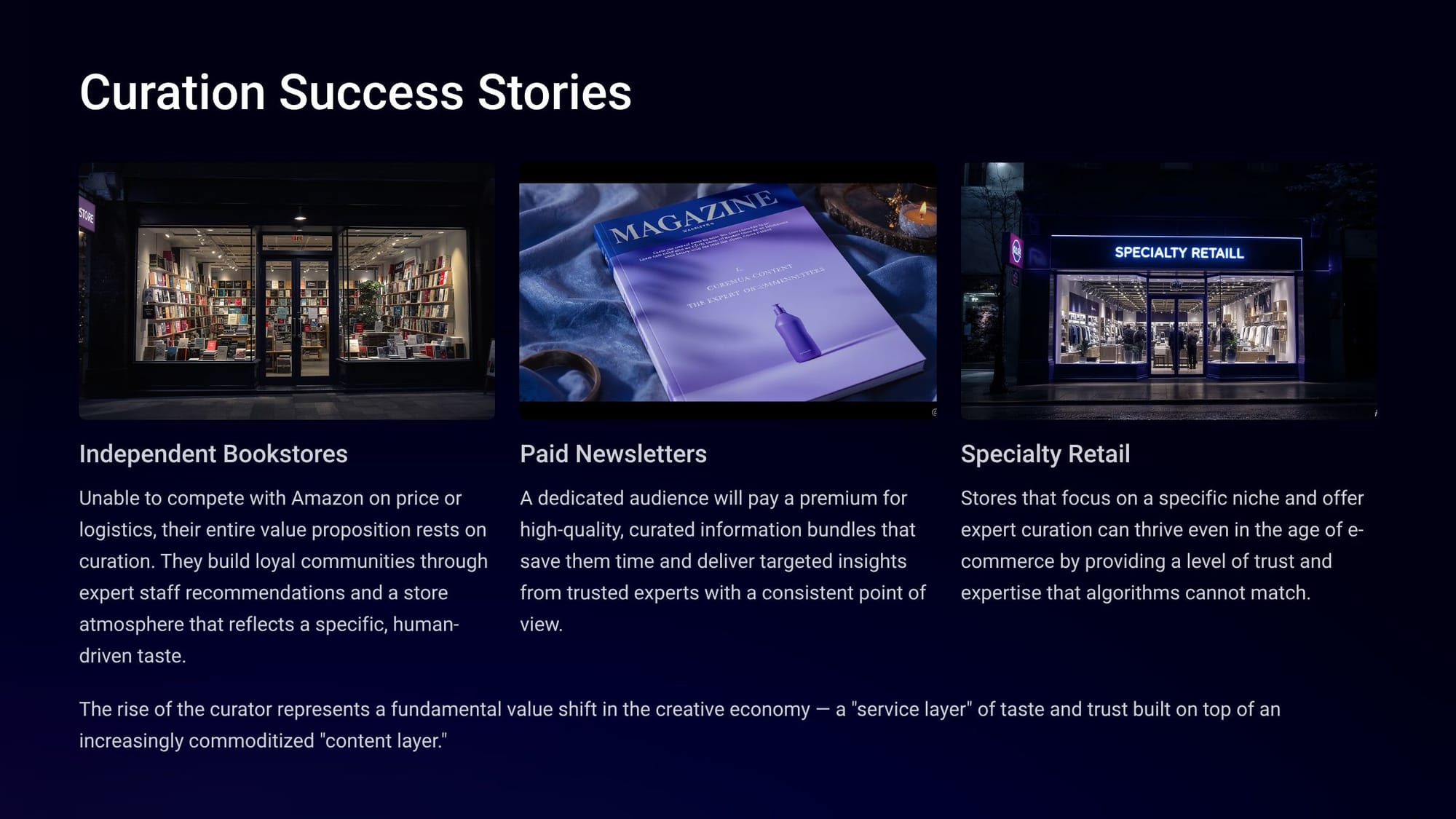
In the future? We can expect to see a lot more authenticity across many more industries:
1. Food & Beverage
- Farm-to-table restaurants with open kitchens
- Craft breweries offering brewery tours
- Small-batch producers with transparent sourcing
2. Retail & Consumer Goods
- Artisanal marketplaces with maker stories
- Limited edition products with numbered series
- Brands highlighting ethical manufacturing
3. Media & Entertainment
- Live streaming with real-time audience interaction
- Documentaries showing the creative process
- Podcasts with unscripted conversations
4. Professional Services
- Personalized client relationships
- Transparent decision-making processes
- Human expertise with AI augmentation
Across all sectors, businesses will find ways to emphasize human elements, showcase transparency, and build trust through authentic connections.
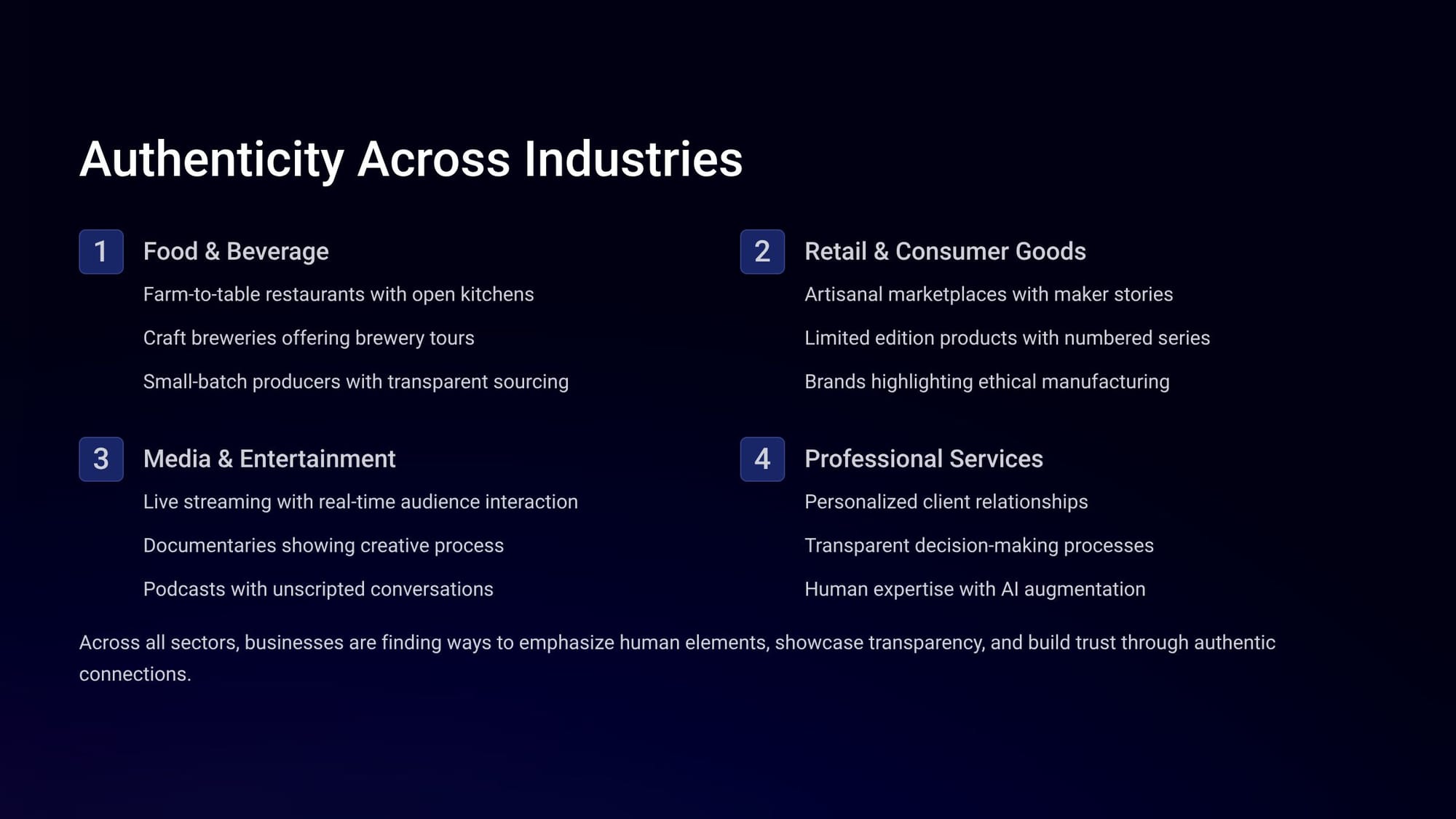
Key Takeaways
- The Authenticity Premium is a rational market response. As AI makes synthetic content abundant and cheap, economic value naturally shifts to what becomes scarce: verifiably human creation, connection, and experience.
- This trend is already visible across markets. From the booming live experience economy to the resurgence of vinyl records to the establishment of "human-made" certifications, consumers are demonstrating a willingness to pay more for authenticity.
- A bifurcated market is emerging. AI will excel at utility, efficiency, and democratizing creation, while human-led work will command a premium for trust, status, and emotional resonance.
- Organizations must strategically balance AI and human elements. Success will come from leveraging technology to amplify what is irreplaceable about being human, not from perfectly imitating humanity with machines.
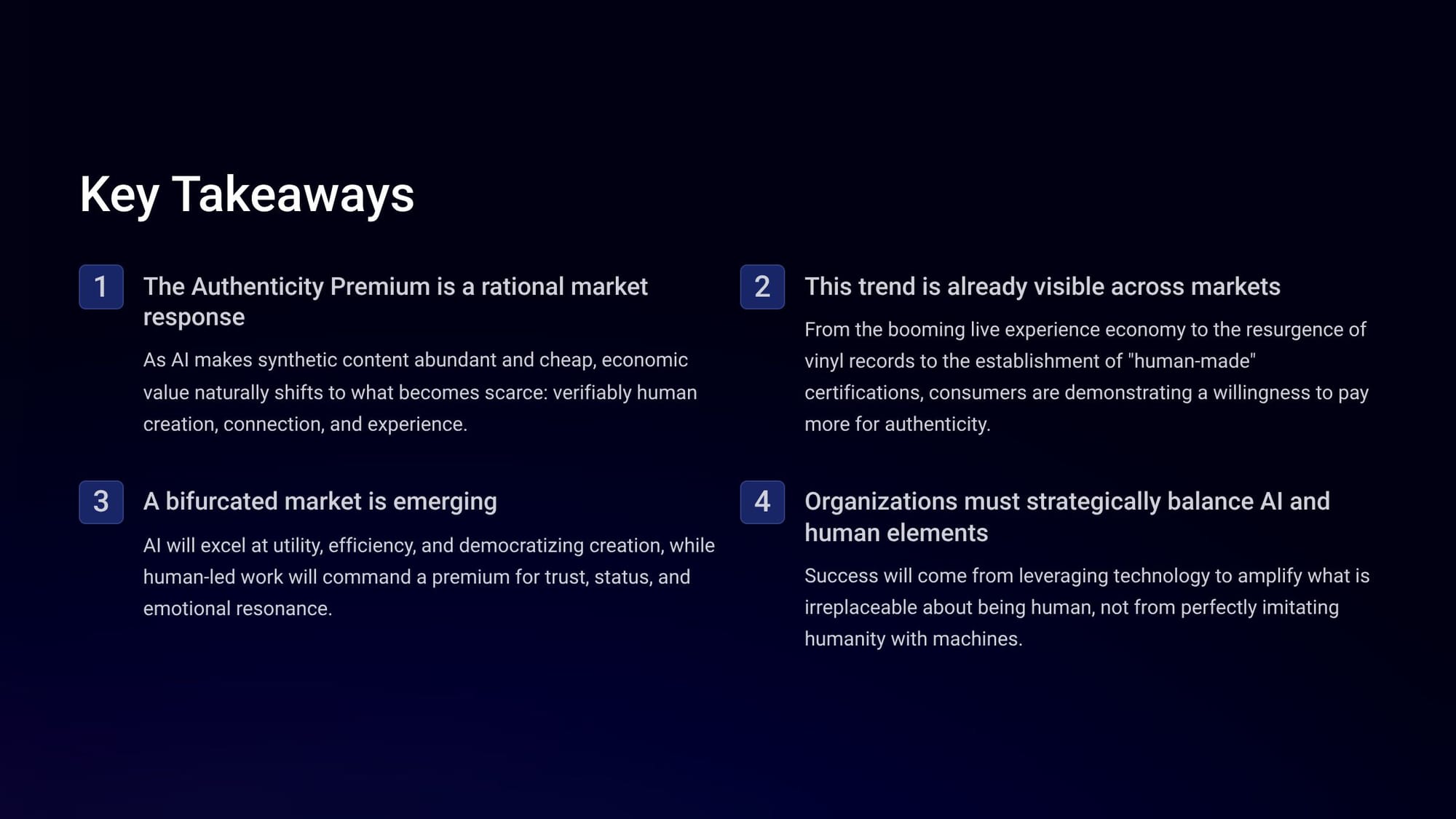
What does all of this mean for you?
I am certainly a big advocate that we need to learn and master all the various AI tools that are coming our way - after all, you won't lose your job to an AI, but you might lose your job to someone using an AI!
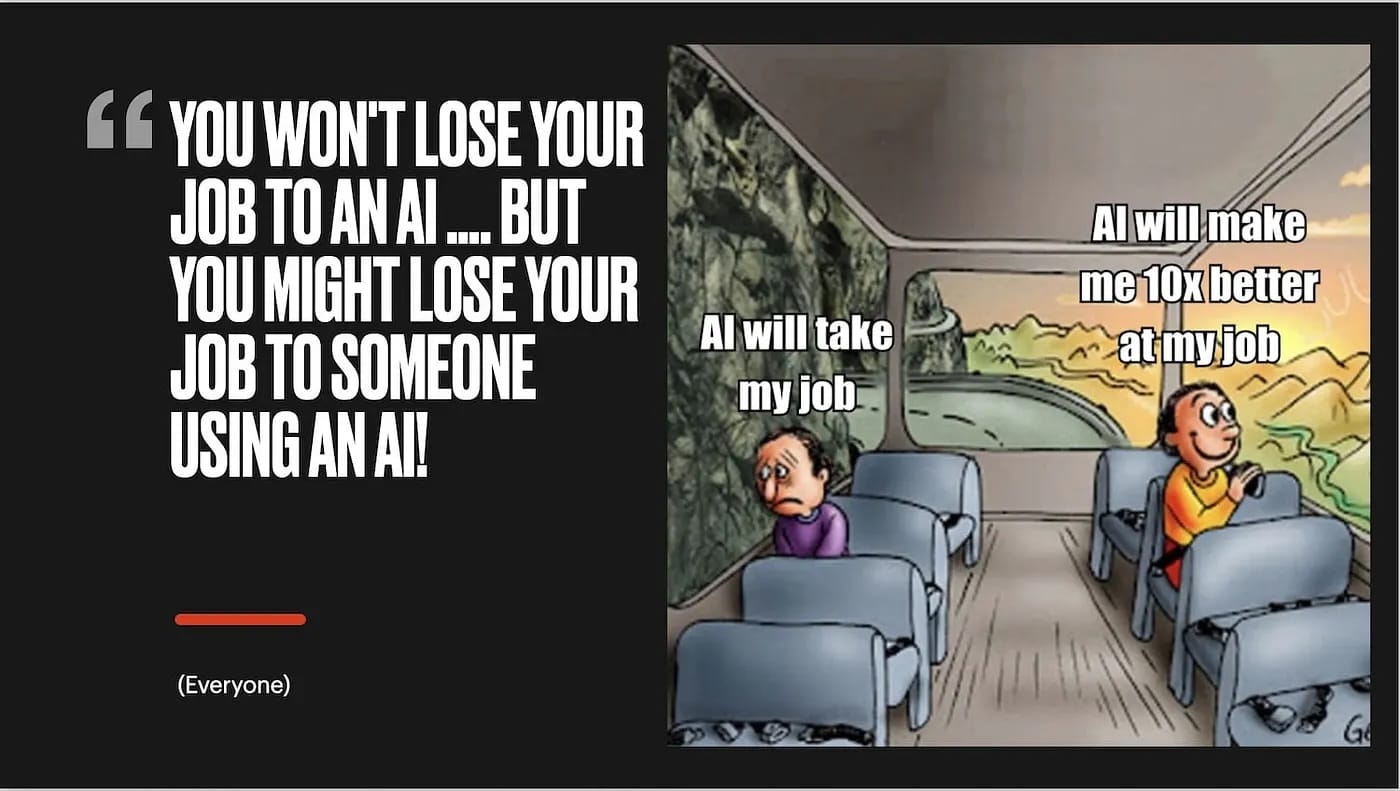
That being the case, you just might be able to keep your job by ensuring that you've got an element of reality in all the work that you are doing with AI, because being real will matter!
Futurist Jim Carroll predicts the words 'real' and 'authentic' will see a sudden resurgence in just about everything people and companies do.

